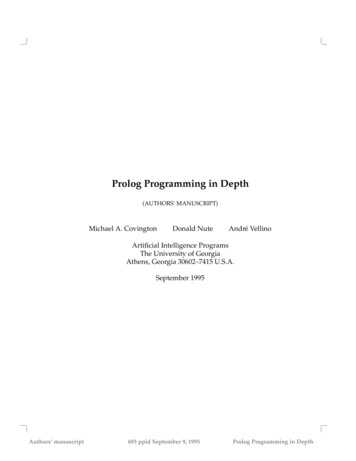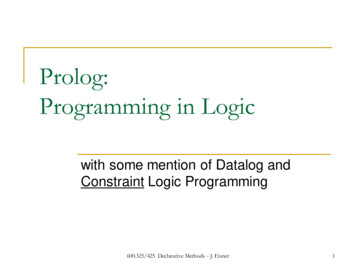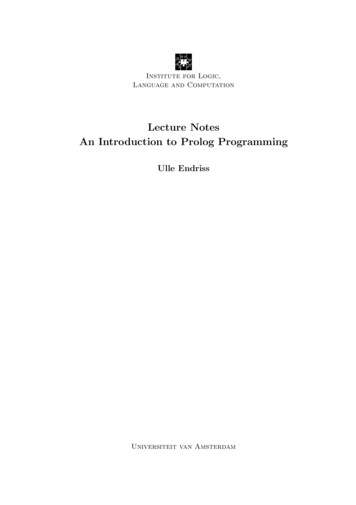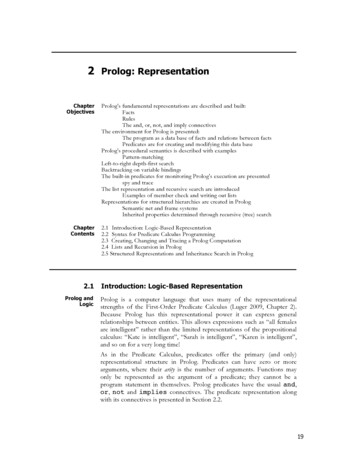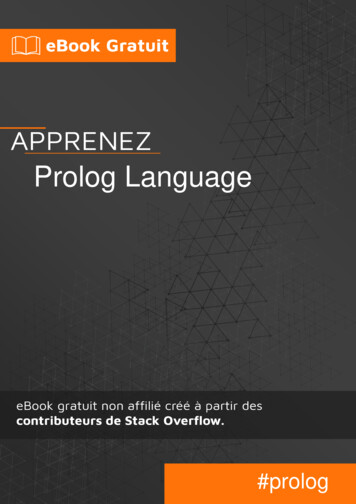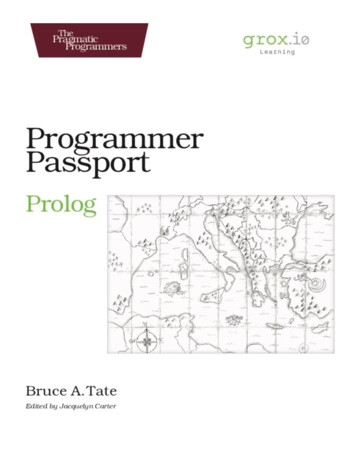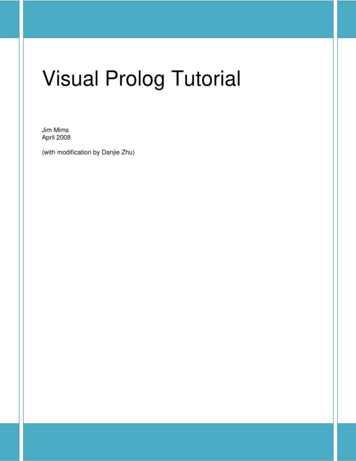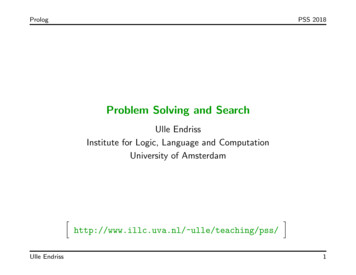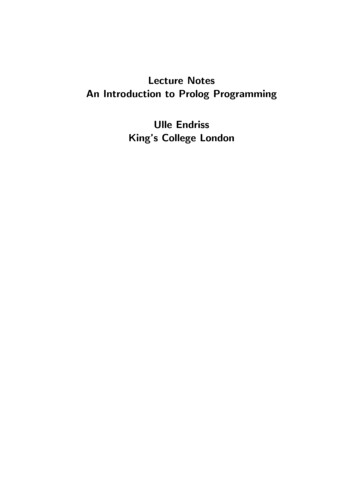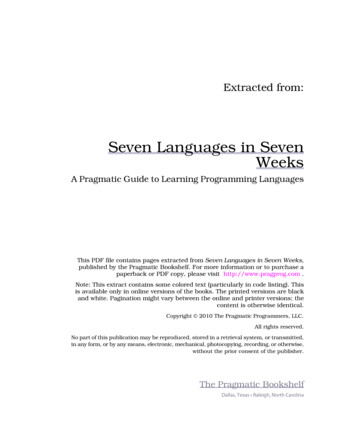
Transcription
Introduction to PrologThe name Prolog stands for Programing Logic. It is an excellent tool to experiment with databases, algorithms, andprograms. It is often used for expert systems. It is unique in its ability to handle logical and algebraic concepts. AtCSUS B I suppo rt an industrial strength, po rtable, and free Prolog interpreter called SW I Pro log. Y ou ca n get abinary executable for M SW indows. The de pt also supp orts another free version of Prolog from the G nu peoplecalled gprolog. These notes were written for SW I Prolog. There are a few notes on Gnu Pro log. How to run P rolog on CSUSB Computers. StartFor a quick experimental run use SWI Prolog and input the UNIX command: pl(Your input as a user will be underlined in these notes). If the above fails you may ne ed /sha re/bin in your P AT H.For the Gnu version use: gprologSW I Prolog source files have the suffix .plg. Gnu Prolog uses suffix .pro. Use your favorite A SCII edito r toprepare them. SW I 'pl' acts like the C and C compilers on UN IX. To co mpile files, load them, and start theinterpreter input this command: pl file1 file2 .To compile files into "a.out" type: pl -c file1 -c file2 .OR gplc file1The result is put in an executable program called a.out If a syntax error o ccurs in a file, the error message willinclude the name o f the file and the num ber o f the line in which it occ urred . To com pile and output an executableprogram called p use: pl -o p-c file .OR gplc -o p file .If the Prolog p rogram is in a single file you can use Q/quickie in the usual way. Interacting with a Prolog ProgramA Prolog pro gram promp ts for input like this:?The user enters commands and queries. Each must be terminated by a period. The p eriod is very impo rtant. CommandsTo exit from Pro log eithe r input C TR L/D or the q uery:?- halt.To look at the loaded pro gram/database, input?- listing.To look at a definition of name in the database/program, input?- listing(name).To ask for help input?- help(name).To look for help on a topic word try inputting?- apropos(word).To load a program from a file, input?- consult('name.plg').and the system finds and compiles the file 'name. plg' looking in the standard libra ry and then the working directory.To save the current data base in file name.plg:?- tell('name.plg'), listing, told.You can ad d new rules or facts to the program/database by inputting?- assert( rule ).For example:?- assert( event(jun,5,lab('18 Prolog101')) ).place s a new fact in the d ata base. Try it!
. QueriesIn addition to commands, a user can input queries. Each query terminates with a period. A query can be any Prologstatement with variables in it. Variables are capital letters. Prolog then searches for a set of values for the variablesthat satisfy the statement or goal. Prolog then and prints out the values. Fo r exam ple?- X*Y Z 1*2 3.If you inp ut the ab ove Pro log will tell you that X 1, Y 2, and Z 3 , try it!If the Prolog pro gram/datab ase co ntains this fact:event(jun,5,lab('18 Prolog101'))then the query?- event(jun,5,lab('18 Prolog101')).would produce the response:Yes.And the query?- event(Moth, Day, Event).would p roduce a response that matches the d ata in the database , like this:Day 5Month junEvent lab('18 Prolog101')This query:?- event(jun,6,lab('18 Prolog101')).would produce the response:No.unless the re was another matching 'event' in the program/datab ase. If the filehttp://www .csci.csusb.ed u/dick/cs32 0/schedule.plgis downloaded into your home directory then it can be loaded as a databa se/program like this:?- consult( 'schedule.plg' ).and searched by co mman ds like this:?- event(jun,5, What), write(What).This com mand tells us the value o f What that matches the third arg ument in the schedule for that day. Execution And InterruptionExecution of a goal starts when you input it as a query. Only when execution is complete does the programbecome read y for another directive. However, one may interrupt the normal execution of a directive by typingCTRL /C. This interrupt signal has the effect of terminating the execution of the command. Prolog will thenrespo nd with a pro mpt. E xecution may also b e terminated if the program runs out of stack space. Th is usuallyindicates an error in your program. Sample QueriesYou can run these without loading a program. Input just the underlined parts. Do not forget the period s.In Prolog 'X' is a 'variable' but 'x' is a constant:?- X 1.?- x 1.?- X x.?- x x.One variable can not have two different values at once:?- X 1, X 2.No.However we c an give two (or more) va riables values:?- X 1, Y 2.X 1Y 2Yes.Prolog aba ndo ns all variab le values when a query is finished. The variables are held on a stack with one level foreach definition being executed. P erma nent values mu st be record ed in the program/datab ase -- and perhaps saved ina file before Pro log finishes.
The following command:?- member(3,[1,2,3]), write (ok).makes Prolog check whether 3 belongs to the list [1, 2, 3], and to output "ok" if it does. If no solution can befound , the system simply returns "N o" and a '?-' pro mpt:?- member(4,[1,2,3]), write (ok).If a variable is included in a query then a possible value is displayed:?- member(X, [tom, dick, harry]).X tom Return ?Prolog can generate a series of alternative answers. A fter the first answer is given to a query, the pro gram then waitsfor ';' (Prolog for "or"), and will then sea rch for another solution.?- member(X, [tom, dick, harry]).X tom ;X dick ;X harry ;NoSuch a series o f answers can b e passed into later parts of a query. Prolog will redo a predicate if a later pre dicatefails. For example we can make X equal every digit in turn and then test to see if the value of X*X is 4:?- member(X,[1,2,3,4,5,6,7,8,9] ), write(X), X*X : 4.1 2 3 4 5 6 7 8 9X 2 ;NoThe query belo w finds digits that are squares of digits:?- Digits [1,2,3,4,5,6,7,8,9], member(X,Digits), member(Y,Digits), X is Y*Y.Y 1X 1 ;Y 4X 2 ;Y 9X 3 ;No. TracingPro log interpreter provides a tracing facility. This is turned on by putting the trace comm and before the q uery:?- trace, query.Tracing stays on for that one query only. Predicates may be individually traced enabling each call or exit involvingthe pre dicate to be displayed on the term inal with the current values o f its argume nts. The events traced are:CallExitFailAfter reporting an event the program waits for o ne of a numb er of ac tions by the user - 'h' gives a list of possibilities,'a' aborts execution and tapping return lets the program continue. Call indicates that a predicate is being called forthe first time. A line beginning with Exit shows the interpreter exiting a clause after all the goals have beensatisfied. Fail indicates an ex it from a clause due to a failure in sa tisfying a goal. An example of tracing o utput isshown below:5?- trace, member(X, [1,2]).Call: ( 5) member(G912, [1,2]) ? Enter creepExit: ( 5) member(1, [1,2]) ? Enter creepX 1 ;Exit: ( 5) member(2, [1,2]) ? Enter creepX 2 ;Fail: ( 5) member(G912, [1,2]) ? Enter creepNoExplanation Enter is where I tapped the Enter or R eturn ke y, ; is where I tapped the semicolon. The rest is outp ut by Prolog.The G 912 is the internal name given to the variable X. Prolog replaces variables names by numbered variables. Thefirst call of member has actual parameter G912, membe r returns G912 1 -- the first item in [1,2]. We have an in-outmode in Prolog! Prolog then prints its discovery that X 1. I reply with a semicolon and it tries again. This time
member finds G912 2. . The third time member finds NO more values and so Fails. Prolog prints out "No".Example with Backtracking:6 ?- trace, member(X,[1,2,3,4,5] ), X*X : 4.Call: ( 5) member(G1548, [1,2,3,4,5]) ? creepExit: ( 5) member(1, [1,2,3,4,5]) ? creepCall: ( 5) 1 * 1 : 4 ? creepFail: ( 5) 1 * 1 : 4 ? creepExit: ( 5) member(2, [1,2,3,4,5]) ? creepCall: ( 5) 2 * 2 : 4 ? creepExit: ( 5) 2 * 2 : 4 ? creepX 2 :((((((((((5)5)5)5)5)5)5)5)5)5)member(3, [1,2,3,4,5]) ? creep3 * 3 : 4 ? creep3 * 3 : 4 ? creepmember(4, [1,2,3,4,5]) ? creep4 * 4 : 4 ? creep4 * 4 : 4 ? creepmember(5, [1,2,3,4,5]) ? creep5 * 5 : 4 ? creep5 * 5 : 4 ? creepmember(G1548, [1,2,3,4,5]) ? creepNoNote: The Gnu Prolog trace give different ou tput.A U seful Predicatethe member(Item, List) predicate is useful for finding items in a list. The select(List, Item, Rest)pred icate gets the Item from the list and sets Rest to the reduced list. In G nu Prolog you have to writeselect(Item, List, Rest). Suppose for examp le we wanted to be sure that we want to find two differentdigits where one is the square of the other. In SWI Prolog we write:?- Digits [1,2,3,4,5,6,7,8,9], select(Digits, X, Rest), member(Y, Rest), X is Y*Y.Y 4X 2 ;.Y 9X 3 ;NoIn Gnu:?- Digits [1,2,3,4,5,6,7,8,9], select(X, Digits, Rest), member(Y, Rest), X is Y*Y.Y 4X 2 ;.Y 9X 3 ;No
CS320 Introduction to Syntax and Semantics of Prolog. LexemesPro log is highly case sensitive and spa ces are significan t. ProgramsPro log source code is made up o f a sequence of clauses, directives, and com ments. The text of a p rogra m isnormally created separately in a file (or files), using any ASCII editor.source code:: #(clause directive comment ).Any characters following the %' character on any line are treated as part of a comment and are ignored.comment :: "%" #no n(end of line) end of line.Directives are w ays of directing the com piler to execute so me goa l or goals during the comp ilation process:directive :: ":-" goal.A T ypical directive is like this::-op( , xfx, 9000).Typical clauses in source code are either definitions or facts.clause:: definition fact.definition:: pred icate ":-" goal "."fact :: pred icate ".".Exam ple definitions:get wet:-its raining, no umbrella.get wet:-swimming.get wet:-fixing(sprinklers).(1) You normally can not redefine a predefined pred icate. (2) Several definitions can all define the same pred icateand their sequence is often im portant. (3) A goal is usually a list of predicates sep arated by commas. Predica tesSyntactically a predicate is just a term. In a clau se it com es before the ":-". T o act as a predicate it must be called ina query or from a goal.pred icate:: com pound term.Exam ple pred icates:it is raininghas('Jim', 'red hair')event(mar, 5,X).class(cs320, 4, 'Programm ing Languages', [cs202, m272 ]). StructuresStructures in Prolog do not have to mean anything. The meaning comes from how they are used and what is storedprogram/database. In a way Prolog is closer to algebra than arithmetic.Expressions are stored and only evaluated when special predicates areinvoked. Prolog parses compound terms as tree structures. So 1 B hasa at the top and 1 and B as leaves. Prefix, infix and p ostfixoperators exist and more can be defined. Comma, semicolon, and ":-" arepred efined infix operators. Pro log already understands m athem atical syntax, precedence and associativity. Internallyall structures are converted to the special functorial form defined below:com pound term:: functorial form operational form list.operational form :: prefix arg arg infix arg arg postfix .functorial form :: functor "(" arg, arg, arg, . ")" functor .Note: Spaces m ay not occur between the functor and the parenthesis!functor:: term.Operators are special terms. A functor is any atomic term where:term:: identifier that starts with a lowe rcase letter string operator.The arguments can b e compound terms, constants and variables:arg :: compound term con stant varia ble. ListsProlog lists are shown this:list:: "[ ]" "[" element, element,. "]" "[" head " " tail "]".The following two expressions are the same:[ 1, 2 ,3 ,4] [1 [2,3,4]].
. VariablesIn Prolog a varia ble has an UPP ERC ASE letter or an underscore( ) as its first character. All other identifiers,operators, and numbers are atomic con stants. The variable " " is a special wild-card variable that can have anyvalue. Each occurrence of " " is treated as a different variable. ConstantsConstants are atomic terms. An identifier (starting with a lowercase letter) is an atom. So is any defined operator(like o r : ). Single q uoted strings like 'A1 23' are treated as atom s - even if they begin a cap ital letter. Doub lequoted strings indicate an array of integers for the ASCII numb ers of the contents of the string.string:: single quoted string double quo ted stringAny com pou nd term made up of constants is also a constant -- an item of data that can be stored and manipulated aswe wish. The meaning of constants is determined by the program/datab ase plus som e predefined term s. Semantics. Data baseAll permanent data is stored in the datab ase as a co llection o f clauses. Programs are stored in the same way ion thesame database. Clauses are extracted from the database by matching variables up to particular values or instances. Ifno matching fact or clause is found then the search fails.In Prolog: data and program are stored using the same notation and structure. A predicate has a unique name and anumbe r of argumen ts (its arity -- this is not a typo). Its meaning varies depending o n the co ntext - it can b e a da tastructure , prog ram, o r an axiom. A form like thishas('Jim', 'red hair')is stored as a tree with has at the top and 'Jim'' , and 'red hair' at the bottom. User InteractionThe user inputs a query, Prolog looks up possible answers in the data base/program and presents them to the user. VariablesAll variables are temporary and local. Permanent data must be placed in the database. Prolog searches for valuesfor its variables. Each value is called an instance. Prolog binds the instance to its variable. It can bind equalvariables to each other. These bindings are temporary. Prolog keeps deducing values until it has processed all thefacts(success), or it fails to find a matching definition or fact, or it is about to change a value of a variable(failure)!Once an instance has be en found it is fixed. Prolog can not change it without undo ing the command that created theinstance. It can then backtrack, delete the instance(value) and try an alternative. At the end of a search(fail orsucceed) all variables loose their va lues. The only perm anent storage is the database. UnificationVariables get temporary values by a process called unification. Alternative definitions can uncover new temporaryvalues. Each is an instance and the variable is then said to be instanciated.Unification forces two expressions to match by (1 ) instantiating variab les as co nstants, and (2) linking va riabletogether. This is done, piece by piece, throughout the two expressions, in parallel. For example X Y *3 matches 1 X *Z when X Y 1 and Z 3 . Unification do es NOT evaluate expression s. If f1 and f2 are functors then f1 ( a1) f2 ( a2 ) only if f1 f2 and a1 a2.Prolog uses unification whenever it calls a predicate. The name of the predicate is found in the database and theargum ents in the datab ase are unified with the argume nts in the ca ll. So ifa(1). a(2).are in the datab ase the query:?- a(X).will generateX 1Tapp ing ';' (or) givesX 2
. EqualityTerms are equal ( ) only if they can be unified. The que ry?- A 1 B, B 3.unifies A with 1 B. Then B is unified with 3. So A is known to equal 1 3 as well. The 1 3 is not evaluated, So,B 3A 1 3is output. Notice that A*B 1*2 3 is false but A B 1*2 3 if A 1*2 and B 3 because of the predefined priorities of* and . Evaluating ExpressionsNormally Prolog treats an expression like 1 B as a data structure and doe s not evaluate it. However, the operator is does evaluate its right-hand expression:?- B 3, A is 1 B.A is instanciated to 4 rather than 1 3. The same thing happens here:?- C 1 B, B 3, A is C.Evaluation o nly occurs in certain predicates:is, , , , \ , : , , ,.In X is E the E is evaluated and X becomes the value or else X's value tested vs. result. Evaluation is on the RHSof 'is' only. Both E1 and E 2 are evaluated in: E 1 E2, E1 E2, E1 : E 2(eq ual value), E1 \ E 2(different value),E1 E2, E1 E2.Exam ple. Finding all two digit numbers that are the sum of the squares of their digits:?- D [1,2,3,4,5,6,7,8,9], member(X,D), member(Y,D), 10*X Y : X*X Y*Y. FactsProlog searches its database for clauses that match the current query. Suppose this is in the database:e(0).Then this is a fact and unifies this with a query like e(0) or e(X) but not e(1) or e(x). Prolog unifies e(X) byinstantiating X to 0. ClausesA clause has a :- in it, like the following:e(N):- N 0, M is N-2, e(M).This can be read e(N) is true if N 0 and M is N-1 and e(M) is true . Prolog first matches e(N) vs the query bysetting the argument N , then it executes each of the three sub -queries ( N 0?, M is N-2, e(M )) in turn. The clausefails the moment any sub-query fails. The clause succeeds and exits only if all succeed in turn. For example, giventhe above clause is in the database the query:?- e(4).matches it with N 4, and so P rolog executes in turn:4 0M 2and then executese(2)In turn, e(2) is looked up in the database and a new N is matched to 2 and a new M is set to 0, thus calling e(0). Ifthere are no o ther definitions in the database this rule never terminates!
. DefinitionsA de finition de clares a series of alternative clauses for the same term. If there are several different (evenconflicting) definitions then any one of them can be true. Prolog searches for the first one to match the goal. If itfails Pro log go es on to the next one. For example, ife(0).e(N):- N 0, M is N-2, e(M).e(N):- N 0, fail.is in the program/d atabase, and you ask?- e(0).Prolog immediatley finds e(0) and reports success. But this query?- e(-1).skips the e(0) because 0 and -1 are different and next tries the 2nd clause e(N) and sets N -1. But N 1 fails whenN -1. Prolog next tries the last clause with N -1, and fails. Since there are no more clauses Prolog treats as e(-1)as false.The following query?- e(1).does not match e(0) . It matches e(N ) with N 1. 1 0, so M is set to -1. P rolog calls e(-1) which fails. Thisfailure makes the second clause of e(1) fail. Prolog tries the last possibility, setting N 1 but then N is not less than0. so e(1) is false.Similarly the que ry:?- e(2).does not match e(0) but does match e(N) with N 2 and N 2. So Pro log now sets M 0 and tries to match e(0), andfinds that this matches the first clause. So this query succeeds: e(2) is true.If you try?- e(3).it does not match e(0) and does fit e(N) with N 3 and so Prolog tries M 1 and tries to match e(1). But we knowalready that e(1) will ultimately fail and so Prolog will exit and try the last clause. This also fails. So e(3) is false.You pro ve this to yourself by inputting?- trace,e(3).If you do more tests you will find out that e(N) is true prec isely when N is a po sitive multiple of two and falseotherwise. Thus 'e' is short for 'even'. The mea ning of 'e' is determined by the program/database. With a differentset of rules e(N) could be mad e to mean other things. R eso urces o n th e W W Whttp://www.csci.csusb.edu/dick/cs320/prolog/
. Punctuation.:,;End of clause/queryifand then (also in list)or else. Predefined Operators A- AA * BA BA - B A / BA mod Babs, acos, asin, atan, ceil, cos, cputime, e, exp, float, float fractional part,float integer part, floor, integer, log, log10, max, min, random, rem, round,truncate, pi, sign, sin, sqrt, tan, xor. Predefined RelationsEquality:E1 E1 if they can be unified, E1\ E2 if they can't.Evaluation: V is E:: evaluate E and unify value with V.Arithmetic comparison evaluate both arguments and compare: , , , \ , : , , ,.Lexicographic comparison:@ , @ ,. Predicatesatom(X):: True if X is an atom .atom length(A,N) :: N is length of atom A .atomic(X) Type check for primitive .compound(X):: Test for compound term .fail:: Always false .ground(T):: T has no free variables .number(X):: Type check for integer or float .string(X):: Type check for string .true:: Succeed .var(X):: Type check for unbound variable . List Operationsappend(L1,L2,L3) :: Concatenating L1, L2 gives L3 .findall(X,G,L) L is List of all the X that solve G .forall(G1,G2):: For each solution of G1 prove G2 .last(E,L):: E is last element of a list L .length(L,N):: N is length of a list L .maplist(P, L1, L2) :: Apply P to pairs in L1 and L2 .member(E,L):: E is a member of a list L .nth0(I, L, E):: I-th element of L equals E, start at 0 .nth1(I, L, E):: I-th element of L equals E .select(L1, E, L2):: E is in L1 and L2 is rest of L1 .setof(X, G, L) L is a sorted list without duplicates of all X that solve G .sort(L1,L2):: Sort L1 giving L2 . Atomsname(A,L):: atom A matches list L in ASCII .concat(A1,A2,A3):: Append two atoms . Stringsatom char(C,A):: atom C is ASCII A .atom chars(A,L):: atom A is list L of ASCII .string length(X,N):: Determine length of a string .string to atom(S,A):: Convert string S to atom A .string to list(S,L) Convert: string and list of ASCII .
. Database Operationsabolish(F,N) :: Remove the definition of F with N arguments .assert(P):: Add clause P to the database .clause(H, T):: find next clause to match H:-T. .consult('F'):: Read and compile source code file F .ed:: Edit last edited predicate .ed(P):: Edit a predicate .listing:: List program .listing(F):: List predicate F .retract(P):: Match & Remove clause . Save Databasetell('filename '), listing, told. Systemabort:: Abort execution, return to top level .apropos(word):: Show related predicates .halt:: Exit from Prolog .halt(N):: Exit from Prolog with status N .help:: Give help on help .help(X):: Give help on X .ls:: list current directory'.op(Symbol, Form, Priority):: Declare an operator .statistics:: Display various stats .shell:: Execute interactive subshell .shell(Command):: Execute OS command .time(G):: Determine time needed to execute G .trace:: Start the tracer . Input and Outputget(X) Read first non-blank character .get0(X) Read next character .nl:: print a newline .print(X):: Print term X .put(C):: Write character C .read(Term):: read next term(with period) on input and unify with Term .see(File):: Change the current input stream .seeing(X):: Unify X with the current input stream .seen:: Close the current input .skip(C):: Skip to character C in current input .tab(N) :: Output N spaces .tell(File):: Change current output stream .telling(X) :: X is the current output stream .told:: Close current output .write(Term):: Write Term .write ln(Term):: Write term, followed by a newline . Logic and ControlV is E:: evaluate E and unify value with X.E . [F A] :: E has form F(A) . -- constructs/analyze functorial forms.once(P):: don't redo P .! :: cut off all backtracking here . -- remove choice points.P,Q:: P and then Q.P;Q:: P or else Q.P- Q:: If P then Q , Safer to be explicit: (not(P); Q).not(P):: try P. True if P fails, else false .repeat:: Succeed, with infinite backtracks .
CS320 E xamples for Prolog laboratoryOver the page is the beginning of a unusual detective story that stars Sherlock Homes and Babbage's AnalyticalEngine. Read the story and then try to match up the Prolog code belo w to the facts that Sherlock H ome s has no ted inthe story.% In Elementary Pascal, Ledgard & Singer have Sherlock Holmes program% the Analytical Engine to confirm the identity of the murderer of% a well known art dealer at the Metropolitan Club in London.% The murderer can be deduced from the following apparently trivial% clues.murderer(X):-hair(X,brown). % the murderer had brown hairattire(mr holman, ring). % mr holman had a ringattire(mr pope, watch). % mr pope had a watch.% If sir raymond had tattered cuffs% then mr woodley wore the pincenez spectacles% and vice versaattire(mr woodley,pincenez):-attire(sir raymond,tattered cuffs).attire(sir raymond,pincenez):-attire(mr woodley,tattered cuffs).% A person has tattered cuffs if they were in room 16.attire(X,tattered cuffs):-room(X,16).hair(X,black):-room(X,14). % A person has black hair if they were in room X,pincenez).hair(X,red):-attire(X,tattered cuffs).room(mr holman, 12). % mr holman was in room 12room(sir raymond,10).room(mr woodley,16).room(X,14):-attire(X, watch).In the Prolog lab you will be able to download and test the above program.
. Review Questions1. W hat do es a user input to a Pro log interpreter? W hat do es the interpreter do with the inp ut? W hat is output?2. How do you terminate our Prolog? Can you edit the database?3. Is Prolog case sensitive? Is white space significant and if so, where? How many kinds of string? Name somecharacters can be in a string but not in an atom.4. Define functorial form and express 1 2*3 in this form.5. One of the se two queries is true: 2 1 1;2 is 1 1. W hich? W hy?6. How do you distinguish an atom, a string, and a variable?7. One of the se two queries is true: X 1 1;x 1 1.W hich? W hy?8. List a dozen predefined arithmetic operators of SWI Prolog. When are they evaluated?9. W hich arithmetic o perators are prefix? W hich are infix? W hat prio rities do you expect?10. H ow do you print out the load ed datab ase? Can you print out predefined definitions?11. W rite a query that finds three digit decima l numbers that eq ual the sum of the cub es of their digits.12. N ame the pre dicate or co mmand that plac es a single fact or clause in the database. Name the com mand/predica tethat loads a file of facts and definitions into the database.13. What command/predicate removes a single matching clause from the database?13. List the 6 relational operators that evaluate two arithmetic exp ressions and then comp are the results.14. W hat do the following mean in P rolog: atom atom ic, number, var?15. W hat punctuation sym bols act like boolean op erators in Pro log? N ame the eq uivalent of true and false constants.16.If [X Y] [1,2,3] what are X and Y?17. W hat are the functo r names in: fun(A,B), A B, -B, A*B, A*B C, respectively?18. D raw the tree structure of A*B C*D.19. H ow do es X Y 1 differ from X is Y 1? If Y 2 what is the value of X in each case?20. If X 1 and Y 2, then what happens to eac h of the fo llowing: X Y, X is Y, X : Y, and X \ Y?21. U nify married(X,Y) with married(husband(dick), wife(tricia)). Can yo u unify sqrt(4)with 1 1 ? Explain22. C an you unify A*B with 1*2 3? Can you unify A B with 1*2 3? Explain why not and/or how.
Introduction to Prolog The name Prolog stands for Pro graming Log ic. It is an excellent tool to experiment wi th databases, algorithms, and programs. It is often used for expert systems. It is unique in its ability to handle logical and algebraic concepts. At CSUSB I support an industrial strength, portable, and free Prolog interpreter called .
